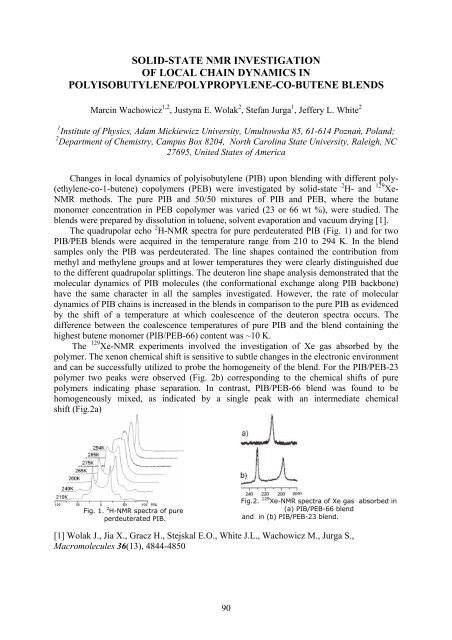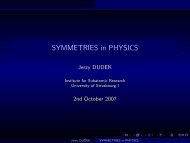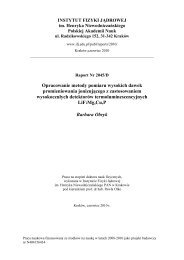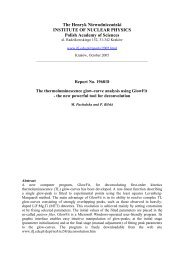Report No xxxx - Instytut Fizyki JÄ drowej PAN
Report No xxxx - Instytut Fizyki JÄ drowej PAN
Report No xxxx - Instytut Fizyki JÄ drowej PAN
Create successful ePaper yourself
Turn your PDF publications into a flip-book with our unique Google optimized e-Paper software.
SOLID-STATE NMR INVESTIGATION<br />
OF LOCAL CHAIN DYNAMICS IN<br />
POLYISOBUTYLENE/POLYPROPYLENE-CO-BUTENE BLENDS<br />
Marcin Wachowicz 1,2 , Justyna E. Wolak 2 , Stefan Jurga 1 , Jeffery L. White 2<br />
1 Institute of Physics, Adam Mickiewicz University, Umultowska 85, 61-614 Poznań, Poland;<br />
2 Department of Chemistry, Campus Box 8204, <strong>No</strong>rth Carolina State University, Raleigh, NC<br />
27695, United States of America<br />
Changes in local dynamics of polyisobutylene (PIB) upon blending with different poly-<br />
(ethylene-co-1-butene) copolymers (PEB) were investigated by solid-state 2 H- and 129 Xe-<br />
The pure PIB and 50/50 mixtures of PIB and PEB, where the butane<br />
NMR methods.<br />
monomer concentration in PEB copolymer was varied (23 or 66 wt %), were studied. The<br />
blends were prepared by dissolution in toluene, solvent evaporation and vacuum drying [1].<br />
The quadrupolar echo 2 H-NMR spectra for pure perdeuterated PIB (Fig. 1) and for two<br />
PIB/PEB blends were acquired in the temperature range from 210 to 294 K. In the blend<br />
samples only the PIB was perdeuterated. The line shapes contained the contribution from<br />
methyl and methylene groups and at lower temperatures they were clearly distinguished due<br />
to the different quadrupolar splittings. The deuteron line shape analysis demonstrated that the<br />
molecular dynamics of PIB molecules (the conformational exchange along PIB backbone)<br />
have the same character in all the samples investigated. However, the rate of molecular<br />
dynamics of PIB chains is increased in the blends in comparison to the pure PIB as evidenced<br />
by the shift of a temperature at which coalescence of the deuteron spectra occurs. The<br />
difference between the coalescence temperatures of pure PIB and the blend containing the<br />
highest butene monomer (PIB/PEB-66) content was ~10 K.<br />
The 129 Xe-NMR experiments involved the investigation of Xe gas absorbed by the<br />
polymer. The xenon chemical shift is sensitive to subtle changes in the electronic environment<br />
and can be successfully utilized to probe the homogeneity of the blend. For the PIB/PEB-23<br />
polymer two peaks were observed (Fig. 2b) corresponding to the chemical shifts of pure<br />
polymers indicating phase separation. In contrast, PIB/PEB-66 blend was found to be<br />
homogeneously mixed, as indicated by a single peak with an intermediate chemical<br />
shift (Fig.2a)<br />
2<br />
Fig. 1. H-NMR spectra of pure<br />
perdeuterated PIB.<br />
129<br />
Fig.2. Xe-NMR spectra of Xe gas absorbed in<br />
(a) PIB/PEB-66 blend<br />
and in (b) PIB/PEB-23 blend.<br />
[1] Wolak J., Jia X., Gracz H., Stejskal E.O., White J.L., Wachowicz M., Jurga S.,<br />
Macromolecules 36(13), 4844-4850<br />
90

















